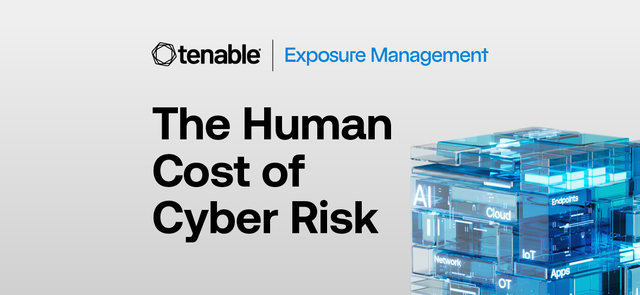The Human Cost of Cyber Risk: How Exposure Management Can Ease Security Burnout

The true cost of cyber risk is a human one. Siloed tools and disjointed operations aren’t just endangering your business, they’re also taking a real toll on your teams. It’s long past time to take the friction out of cybersecurity with a unified, proactive approach.
Key takeaways:
- Security teams are overwhelmed by the number of tools, manual processes, and volume of data required to do their jobs.
- While organizations struggle to get a clear picture of risk, attackers see a map of attack paths.
- Exposure management takes the friction out of cybersecurity, empowering your teams to focus on proactively defending your environment.
While we often talk about cyber risk in business terms, the impact of a cyber attack ultimately affects people’s lives. Think of patients who can’t get life-saving medical treatments because their hospital suffered a ransomware attack. Passengers stranded at airports. Families that can’t close on new homes. The financial and emotional costs associated with fraud and identity theft. People ultimately pay the price for all of these outcomes in one way or another.
Those on the frontlines of your cyber defenses are acutely aware of the human toll of cyber risk. And they’re paying a price too.
Security teams are burning out. They are staffed with brilliant, dedicated experts in cloud, OT, and IT but are forced to work in silos. The cloud admin is overwhelmed. The OT engineer is terrified of a production shutdown caused by an ill-timed patch. The vulnerability management team is drowning in “critical” alerts. The results? Friction, wasted efforts, and a constant fear that the real, business-ending threat is lurking in the gaps.
Here’s a look at the scope of the challenges security teams are dealing with:
- Up to 83 security tools from 29 vendors
- each requiring one or more data connectors
- 300,000 CVEs tracked by MITRE since inception
- instances of unpatched vulnerabilities projected to reach 515 billion by year’s end1
- 670 OT-impacting vulnerabilities disclosed in first-half 2025
- AI everywhere — 89% of orgs are either using AI or piloting it
- Dynamic cloud environments — 82% work in hybrid cloud environments
- 63% juggle two or more cloud providers
I could go on, but you get the picture. When they most need clarity, teams are hobbled by fractured visibility, disjointed action, and uncertainty. Managing vulnerabilities and exposures across all the silos of IT, OT, cloud, AI, and beyond remains far too complex and manual. Teams spend hours — sometimes days — consolidating reports, correlating vulnerabilities, assigning remediation tasks, and trying to figure out what it all means for their organization’s overall risk exposure. They lack a way to connect, unify, and analyze the flood of security data they’re facing on a daily basis.
And when a CEO or board of directors asks a CISO, “Are we exposed?” too often there’s no confident, data-backed answer.
Security teams and the executives they report to are drowning in data, but starving for clarity.
Disjointed defense performed by overwhelmed and dispirited teams is the attacker’s greatest advantage. While your teams struggle to work across silos and get a clear picture of risk, attackers see one interconnected landscape of opportunity in your environment. By chaining together seemingly unrelated weaknesses between vulnerability management, identities, cloud, and operational technology (OT), they build a navigable map of your environment with attack paths your teams simply can’t see from inside their functional silos. Threat actors are waging a unified campaign against your scattered defenses.
Don’t your cyber defenders deserve a unified front?
Cybersecurity isn’t won by individual heroes fighting isolated battles. It’s won with a united front, capable of seeing the entire battlefield as clearly as the enemy does. That’s where exposure management comes in.
Exposure management is a strategic approach to proactive security designed to unify siloed teams, tools, and data. It gives IT and security teams the ability to see the entire attack surface, so they can home in on the greatest threats to your business. With exposure management, you get:
- A single, unified view of the attack surface
- A single, consolidated source of security data
- A consistent approach to risk scoring across security domains
- Capabilities to prioritize and remediate exposures based on business impact and technical context
Together, these capabilities empower you to see how seemingly disparate vulnerabilities, misconfigurations, and excessive permissions combine to create attack paths leading to your organization’s most critical systems and data. With this visibility and insight, you can proactively cut off these exposures at the pass.
See the way exposure management has transformed Tenable’s own security team.
Cybersecurity burnout is a business risk
A Lancaster University study of responsible cybersecurity emphasizes the wellbeing of the people in cybersecurity roles as a key consideration in an organization's security strategy. Study participants reported a high level of burnout, which the researchers say presents risks not only to the individuals but to their organizations and society at large.
It’s long past time to take the friction out of cybersecurity. Your teams deserve a new approach that reduces noise, gives them accurate prioritization guidance, and helps them to reduce risk without burning themselves out. Exposure management gives your teams the strategy and structure, along with the visibility, insight, and action, to join forces and present a unified front.
1 Source: Tenable Research estimate based on telemetry scan data.
Learn more
Get ahead of cyber threats with exposure management.
- Exposure Management



